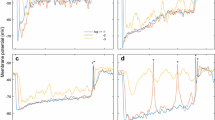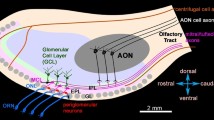Summary
Morphologically identified spiking ocellar interneurons (LB and LD-neurons) of the honeybee (Apis melliferd) were investigated by combined intracellular recording and staining techniques using multimodal stimulus programs.
Response patterns containing both graded and action potentials (mixed response), and pure spiking responses were analysed. Mixed responses allow a comparison of information coded simultaneously by graded and action potentials in one neuron. In most cases the intensity dependence coded by spikes was found to be similar to the intensity dependence coded by one of two different parameters evaluated from the graded signal. Lneurons with mixed responses were unimodal, i.e. they reacted exclusively to stationary illumination of the ocelli, as do nonspiking L-neurons.
In contrast, spiking L-neurons that lacked a graded response component could also respond to stimuli of other sensory modalities: moving patterns, compound eye illumination, airstreams, mechanical and gustatory stimulation. One LD-neuron was also excited by the wing beat.
Recordings from the same type of neuron in different individuals demonstrate that the input modalities and response patterns of L-neurons vary remarkably. Consequently many recordings are required to properly characterise the physiological properties of these neurons even though anatomically they are identified.
The existence of graded and action potentials in the same cell and the fact that these two signals carry different information is discussed in the context of a possible role for information transmission from L-neurons to postsynaptic cells.
Similar content being viewed by others
Abbreviations
- R/I :
-
response/intensity
References
Autrum H, Metschl N (1963) Die Arbeitsweise der Ocellen der Insekten. Z Vergl Physiol 47:256–273
Chappell RL, Dowling JE (1972) Neural organization of the median ocellus of the dragonfly. I. Intracellular electrical activity. J Gen Physiol 60:121–147
Erber J, Schildberger K (1980) Conditioning of an antennal reflex to visual stimuli in bees (Apis mellifera L.). J Comp Physiol 135:217–225
Goodman LJ (1981) Organisation and physiology of the insect dorsal ocellar system. In: Autrum H (ed) Handbook of sensory physiology, vol VII/6C. Springer, Berlin Heidelberg New York, pp 201–286
Guy RG, Goodman LJ, Mobbs PG (1979) Visual interneurons in the bee brain: Synaptic organization and transmission by graded potentials. J Comp Physiol 134:253–264
Hengstenberg R (1977) Spike responses of ‘nonspiking’ visual interneurone. Nature 270:338–340
Hertel H (1980) Chromatic properties of identified interneurons in the optic lobes of the bee. J Comp Physiol 137:215–231
Homberg U (1981) Recordings and Lucifer yellow stainings of neurons from the tractus olfacto-globularis in the bee brain. Verh Dtsch Zool Ges 74:176
Homberg U (1982) Das médiane Protocerebrum der Honigbiene (Apis mellifera) im Bereich des Zentralkörpers: Physiologische und morphologische Charakterisierung. Ph D Thesis, Freie Universität Berlin
Homberg U (1984) Processing of antennal information in mushroom body neurons of the bee brain. J Comp Physiol A 154:825–836
Hoyle G (1955) Functioning of the insect ocellar nerve. J Exp Biol 32:397–407
Kondo H (1978) Efferent system of the lateral ocellus in the dragonfly: Its relationship with the ocellar afferent units, the compound eyes and the wing sensory system. J Comp Physiol 125:341–349
Milde JJ (1981) Graded potentials and action potentials in the large ocellar interneurons of the bee. J Comp Physiol 143:427–434
Milde JJ (1982) Elektrophysiologische und anatomische Untersuchungen an Interneuronen erster und höherer Ordnung des Ocellensystems der Biene. Ph D thesis, Freie Universität Berlin
Milde JJ (1984) Ocellar interneurons in the honeybee. Structure and signals of L-neurons. J Comp Physiol A 154:683–693
Mizunami M, Yamashita S, Tateda H (1982) Intracellular stainings of the large ocellar second-order neurons in the cockroach. J Comp Physiol 149:215–219
Mobbs PG, Guy RG, Goodman LJ, Chappell RL (1981) Relative spectral sensitivity and reverse Purkinje shift in identified L neurons of the ocellar retina. J Comp Physiol 144:91–97
Moore D, Penikas J, Rankin MA (1981) Regional specialization for an optomotor response in the honeybee compound eye. Physiol Entomol 6:61–69
Pan KC (1981) The neural organization of the ocellar system and associated pathways in the central nervous system of the worker honeybee,Apis mellifera. Ph D thesis, University of London
Patterson JA, Chappell RL (1980) Intracellular responses of procion filled cells and whole nerve cobalt impregnation in the dragonfly median ocellus. J Comp Physiol 139:25–39
Patterson JA, Goodman LJ (1974) Intracellular responses of receptor cells and second order cells in the ocelli of the desert locustSchistocerca gregaria. J Comp Physiol 95:237–250
Rosser BL (1974) A study of the afferent pathways of the dragonfly lateral ocellus from extracellularly recorded spike discharges. J Exp Biol 60:135–160
Ruck P (1961) Elektrophysiology of the insect dorsal ocellus. II. Mechanisms of generation and inhibition of impulses in the ocellar nerve of dragonflies. J Gen Physiol 44:629–639
Simmons P (1980) A locust wind and ocellar brain neurone. J Exp Biol 8:281–294
Simmons PJ (1981) Synaptic transmission between second- and third-order neurones of a locust ocellus. J Comp Physiol 145:265–276
Simmons PJ (1982) Transmission mediated with and without spikes at connexions between larger second-order neurones of locust ocelli. J Comp Physiol 147:401–414
Stewart WW (1978) Functional connections between cells as revealed by dye-coupling with a highly fluorescent naphthalmide tracer. Cell 14:741–759
Strausfeld NJ, Seyan HS, Wohlers D, Bacon JP (1983) Lucifer yellow histology. In: Strausfeld NJ (ed) Functional neuroanatomy. Springer, Berlin Heidelberg New York, pp 132–155
Strausfeld NJ, Bassemir UK, Singh RN, Bacon JP (1984) Organizational principles of outputs from dipteran brains. J Insect Physiol 30:73–93
Taylor CP (1981) Graded interactions between identified neurons from the simple eyes of an insect. Brain Res 215:382–387
Wilson M (1978a) The functional organization of locust ocelli. J Comp Physiol 124:297–316
Wilson M (1978b) Generation of graded potential signals in the second-order cells of locust ocellus. J Comp Physiol 124:317–331
Wilson M (1978c) The origin and properties of discrete hyperpolarizing potentials in the second-order cells of locust ocellus J Comp Physiol 128:347–358
Author information
Authors and Affiliations
Rights and permissions
About this article
Cite this article
Milde, J.J., Homberg, U. Ocellar interneurons in the honeybee. J. Comp. Physiol. 155, 151–160 (1984). https://doi.org/10.1007/BF00612633
Accepted:
Issue Date:
DOI: https://doi.org/10.1007/BF00612633




